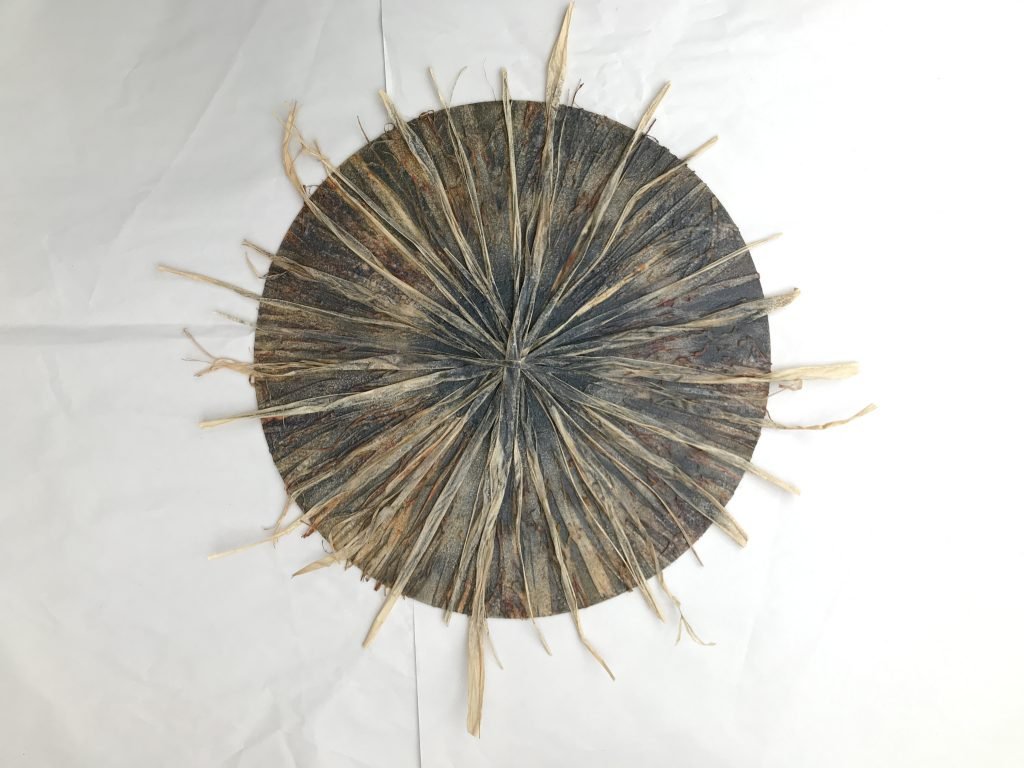My recent work picks up from an idea I have had whilst printing the recent work ‘Moon In a Pewter Sky’ (below).
Like many people, I have always been fascinated with the sun and moon, because of their basic importance to life, illustrated in art and history. This small print inspired me to look again at the basic round shapes and to with associations of heat and cold through colour and texture.
I made an initial set of four circular plates, made with a variety of materials for the textures, from raffia and fabric edgings to acrylic gels. As a set, I really thought that all of them, in their different ways, would print really well. In practice, this was not the case.
Plate 1: acrylic gel, a torn plastic garlic bag, raffia and hessian fibres, plus carborundum powder
I made an initial set of four circular plates, made with a variety of materials for the textures, from raffia and fabric edgings to acrylic gels. As a set, I really thought that all of them, in their different ways, would print really well. In practice, this was not the case. Plate 1, which was full of textures, looked great, but in fact was a bit of a disaster. In the print, there was simply not enough textural or tonal difference coming through. Also, it had been a while since I had used plastic netting on a plate. I had forgotten how ink would just collect below it, preventing the hole patterning to reveal itself – another lesson learned!
Plate 2: acrylic gels, kitchen foil and cotton threads, plus carborundum powder
Plate 2 is promising, but not quite there yet. I wanted this one to be a ‘sun’ image, with hot colours and tones. Some of the details are very interesting, but I feel it needs more depth through darker colours. This may mean re-interpreting it as a ‘moon’ image, but we’ll see what happens in future prints.
Plate 3: raffia strands, plus carborundum powder
Plate 3 also produced some interesting marks in the first printing, needed more carborundum to increase the strength of the marks.
Plate 4: poured varnish and carborundum powder
I’m not sure why, but I left the plate above until last. For this one, I had returned to a poured varnish technique I had last used around two years before. I simply poured matt varnish in pools around the lightly varnished plate. As soon as this was done, I sprinkled carborundum powder onto the wet surface and then blew the mixture around and across the surface. The mixture immediately separates in some areas and coalesces in others. The process is only partially controllable, which I think is a good thing. It produces in near-random shapes, ensuring that each pouring/blowing results in a completely different marks – leading to unique prints.
In this case, it led to what I honestly think and feel is my best print to date, both in terms of aesthetics and technical quality. A contributing factor here was the quality of the inking. I have recently been revisiting books and videos on the techniques of the great printmaker Brenda Hartill. In those, she describes her special inking technique called ‘the rubs’. This involves starting with the main overall colour, before using successive, light applications of accent or highlight colours. In this print, it helped me to achieve a subtle, multi-colour print that I have never obtained before – a real treat!
I’ll be re-making the other plates in the series using some elements of this technique. I can’t wait to see what happens!
Find all my posts about Art Printworks stories on Twitter at: #artprintstories










